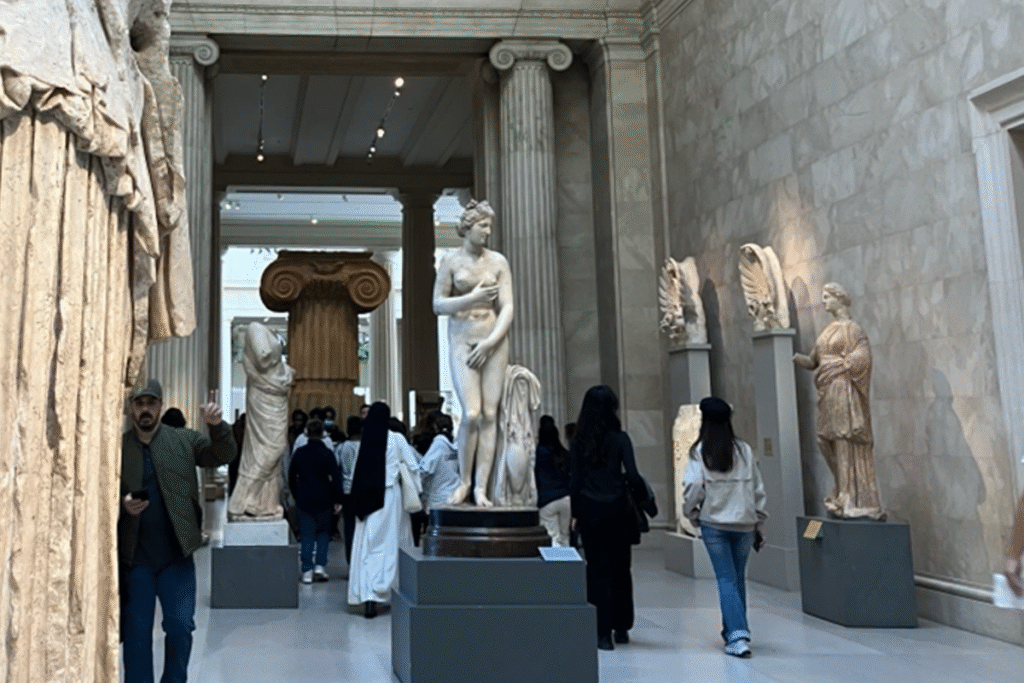Above: Unknown, Statue of the Capitoline Aphrodite, 1st / 2nd century CE with 18th-century restoration. Marble, H. 73 1/2 in. (187 cm). The Metropolitan Museum of Art (MET).
 At the core of the Metropolitan Museum of Art (MET) collections in New York City is a sculpture that captivated all my senses when we visited there on April 15th. This was a statue of the Capitoline Aphrodite, also known as “The Hamilton Aphrodite,” described as “the sculpture was part of Douglas Hamilton’s distinguished collection of ancient art displayed at Hamilton Palace in Lanarkshire, Scotland.(1)”.
At the core of the Metropolitan Museum of Art (MET) collections in New York City is a sculpture that captivated all my senses when we visited there on April 15th. This was a statue of the Capitoline Aphrodite, also known as “The Hamilton Aphrodite,” described as “the sculpture was part of Douglas Hamilton’s distinguished collection of ancient art displayed at Hamilton Palace in Lanarkshire, Scotland.(1)”.
I want to highlight some remarkable aspects: firstly, the statue is a Roman copy based on the sculpture of the Aphrodite of Knidos, carved by the Greek sculptor Praxiteles circa 350 B.C. Secondly, this masterpiece also inspired numerous variations by Roman artists centuries later, including this sculpture.
This Roman masterpiece is a votive statue of Aphrodite carved out of marble; it is idealized to manifest the aesthetic perfection of human anatomy according to the standards of the Canon of Polykleitos. One of my observations is that Aphrodite’s hands obscure her pubic area and her breasts; because of this, I focus my attention on her face. My thought on this little detail is that with this gesture, the author invites me to go beyond the contemplation of her physical beauty and to direct my attention to what matters: such as authenticity, kindness, wisdom, and compassion; aspects encapsulated in Aphrodite’s face.
This sculpture’s iconography manifests nudity. According to John Walford, “while male nudity was admired, female under were shunned and associated with prostitution. In this light, nude Aphrodite (…) quickly became the prototype, or model, for hundreds of subsequent versions that it turn have influenced Western conceptions of female beauty”(2).
Finally, in its composition, I observe a contrapposto with her weight on her left leg, which gives a dynamic balance to the sculpture. Its form is open so that I can look at it from different perspectives. I interpret this detail as the sculptor showing us that the human body was made in order to live in the truth in such a way that as I gaze at it, I find it beautiful from each one of its perspectives. It is a life-size figure, and the marble is polished. According to scholars, “the head of the sculpture is not original to the body but comes from another ancient statue of the same type”(3).
Finally, as a brother in formation and a legionary of Christ, I can use this sculpture as a starting point to invite people to reflect on beauty as a gift from God. By emphasizing that just as Aphrodite directs attention to her face, so too does God call us to look beyond the material and superficial towards the profound and spiritual aspects that relate us to Him.
Foot notes
- A. Bellis, The Met: A Roman Statue of Aphrodite on Loan to the Met, May 9, 2023, in https://www.metmuseum.org/about-the-met/collection-areas/greek-and-roman-art/roman-statue, (Referenced on April 18, 2024)
- J. Walford, Great Themes in Art, Prentice All, China 2001, 76.
- The MET, Statue of the Capitoline Aphrodite, n.d., in https://www.metmuseum.org/art/collection/search/856959, (Referenced on April 18, 2024)



